Abstract
Context:
The type of anesthesia in cesarean section can affect the mother and baby. This study aimed to determine the comparative effect of intrathecal hyperbaric bupivacaine vs. hyperbaric ropivacaine on maternal and neonatal outcomes after cesarean section.Evidence Acquisition:
PubMed, Web of Science, Embase, Google Scholar, IranDoc, MagIran, and Scopus databases were searched from 1 September 2022 to 1 November 2022. Eighteen clinical trials with 1542 patients were included in the analysis.Results:
There was no statistically significant difference in hypotension, bradycardia, and Apgar score between the 2 groups (P > 0.05). The risk of nausea (relative risk (RR), 1.526; 95% CI, 1.175 - 1.981; P = 0.001) and vomiting (RR, 1.542; 95% CI, 1.048 - 2.268; P = 0.02) caused by bupivacaine was 0.53% and 0.54% higher than that of ropivacaine. The incidence of shivering (RR, 2.24; 95% CI, 1.480 - 3.39; P = 0.00) was 2.24 times higher in the bupivacaine group than in the ropivacaine group. The average onset time of sensory block (standardized mean difference (SMD), -0.550; 95% CI, -1.054 to -0.045; P = 0.032) and motor block (SMD, -0.812; 95% CI, -1.254 to -0.371; P = 0.000) was significantly lower in the bupivacaine group than in the ropivacaine group.Conclusions:
Despite the fact that ropivacaine and bupivacaine are effective in cesarean section, ropivacaine is more favorable because of less hemodynamic changes, less duration of sensory and motor block, and fewer side effects, which are effective in patient recovery.Keywords
Bupivacaine Ropivacaine Spinal Anesthesia Cesarean Section Mothers
1. Context
Cesarean section is one of the most common surgeries in obstetrics, the rate of which is increasing significantly worldwide (1-4). The rate of cesarean section has been reported at 42.35% in the world and 47.9% in Iran (5, 6). The correct management of delivery and choosing the appropriate anesthetic method to achieve analgesia and maintain the health of the mother and fetus during cesarean section are of great importance (7). The type of anesthesia used in cesarean section should cause the fewest complications for both mother and baby. For cesarean section patients, spinal anesthesia is a reliable and safer procedure than general anesthesia (8). Spinal anesthesia is often used in emergency and elective cesarean section due to the reduction of anesthesia-related mortality, rapid onset, and complete muscle relaxation (9-12). Less neonatal complications, lower prevalence of failed block, and reduction of pneumonia due to aspiration are among the advantages of spinal anesthesia (10). Bupivacaine is a long-acting amide anesthetic mainly used for spinal anesthesia (13). Ropivacaine is a long-acting amide anesthetic that is structurally very similar to bupivacaine. This drug creates an effective epidural anesthesia for cesarean delivery and is also used in spinal anesthesia (14). The ideal drug for spinal anesthesia should have fewer hemodynamic disorders, appropriate duration of anesthesia, quick return of sensation/movement, and fewer side effects (7). Since various studies have reported different side effects of the intrathecal hyperbaric bupivacaine and hyperbaric ropivacaine in cesarean section, this systematic review and meta-analysis aimed to evaluate maternal and newborn outcomes after spinal anesthesia with intrathecal hyperbaric bupivacaine and hyperbaric ropivacaine.
2. Evidence Acquisition
This meta-analysis followed the Preferred Reporting Items for Systematic Reviews and Meta-Analyses (PRISMA) guidelines. The statistical population of this study included all women candidates for elective cesarean section under spinal anesthesia who received intrathecal bupivacaine or ropivacaine. This study was approved by the Ethics Committee of Ilam University of Medical Sciences (code: IR.MEDILAM.REC.1401.223; grant number: A-10-2341-34).
2.1. Search Strategy and Eligibility Criteria
With no language restrictions, the researchers began searching for clinical trial studies using a systematic search from 1 September 2022 to 1 November 2022. Other studies (such as case reports, abstracts, and review studies) were excluded from the search.
In this systematic search, studies between the years 1995 to 2022 were investigated using the following keywords: Intrathecal bupivacaine or ropivacaine, hypotension, nausea, vomiting, shivering, onset of sensory and motor block, Apgar score, cesarean section, spinal anesthesia, and regional anesthesia. Web of Science, Embase, PubMed, Scopus, Google Scholar, MagIran, and IranDoc databases were searched from 1 September 2022 to 1 November 2022.
Inclusion criteria were the use of intrathecal hyperbaric bupivacaine and hyperbaric ropivacaine, elective cesarean section under spinal anesthesia, onset of sensory and motor block, and assessment of hypotension, bradycardia, nausea, vomiting, shivering, and Apgar score. Exclusion criteria were emergency cesarean section, the use of local anesthesia, studies unrelated to the topic, and studies whose full text was not available.
2.2. Data Extraction
Two researchers simultaneously conducted study selection and data extraction and checked the quality of the studies. The following information was extracted from all studies: Author’s name, country, year of publication, sample size, incidence of hypotension, bradycardia, nausea, vomiting, shivering, Apgar score at 1 and 5 minutes, and onset of sensory and motor block.
2.3. Statistical Analysis
Since the included studies were clinical trials, the effect size consisted of relative risk (RR) and Hedges G (standardized mean difference (SMD)). A fixed-effects model was used for parameters where the I2 index was less than 25%, and a random-effects model was used for parameters above 50%. The Egger test and funnel plot were used to check publication bias. Data were analyzed using Stata version 17 (StataCorp LLC, College Station, Texas, USA). The significance of the year in the studies was carried out using the meta-regression method. P values less than 0.05 were considered statistically significant.
3. Results
Selection of articles: 73, 65, and 116 articles were taken from Web of Science, PubMed and Scopus respectively. After removing duplicates, 58 articles remained. After reviewing the summary of the articles, 31 articles unrelated to the topic were removed. By checking the full text of the articles, due to the use of anesthetic drugs in combination with other drugs, 6 articles were removed, and 2 articles were excluded due to the lack of sample size. Finally, 18 articles with 1542 subjects (6-8, 11, 15-28) were included in the analysis (Figure 1).
The flowchart of the study
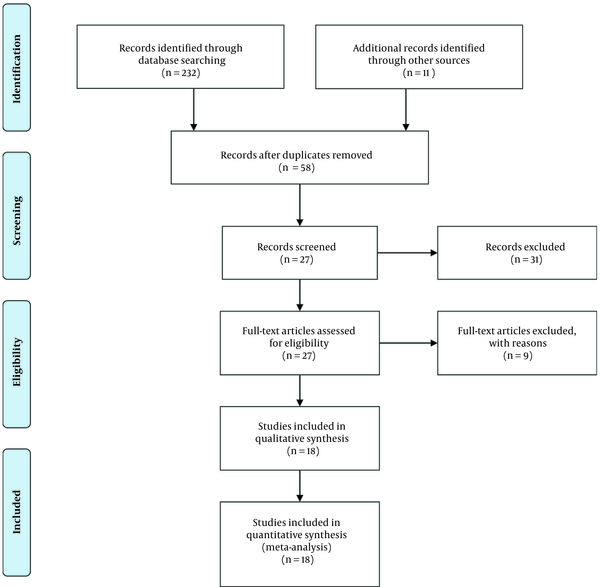
The results indicated that the 2 groups had no statistically significant differences in hypotension (RR, 1.57; 95% CI, 0.932 - 1.198; P = 0.3), bradycardia (RR, 0.785; 95% CI, 0.414 - 1.490; P = 0.4), and Apgar score of 1 (SMD, 0.233; 95% CI, -0.093 to 0.559; P = 0.16) and 5 minutes (SMD, 0.154; 95% CI, -0.135 to 0.443; P = 0.295; Figures 2 and 3, Tables 1 - 4).
Forest plot of hypotension
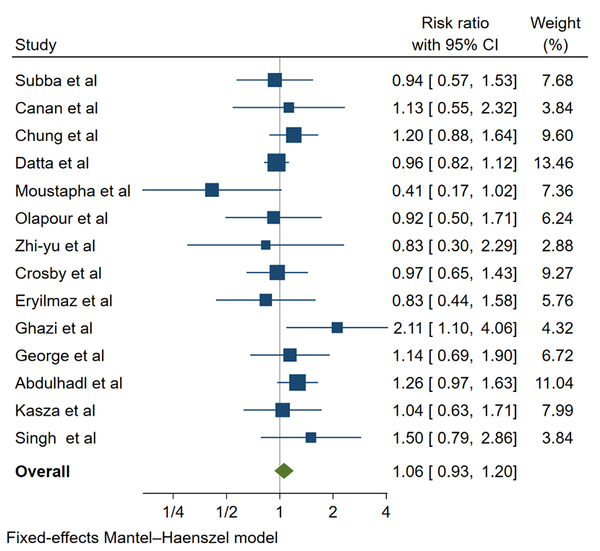
Forest plot of Apgar score at 1 minute
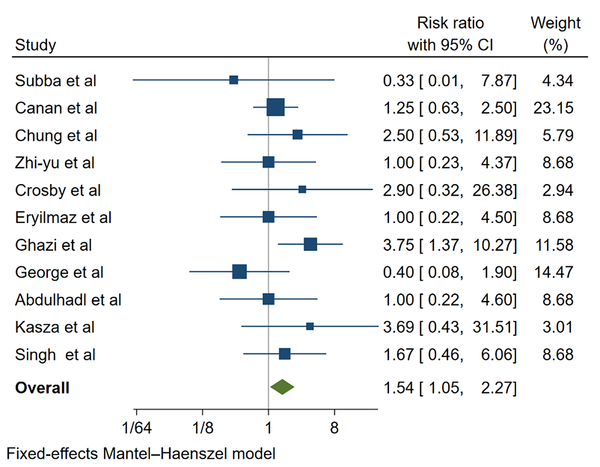
Characteristics of the Studies According to Mean ± SD
| ID | Author | Year | Country | No./B | Mean/B/OM | SD/B/OM | No./R | Mean/R/OM | SD/R/OM | Mean/B/OS | SD/B/OS | Mean/R/OS | SD/R/OS | Mean/B/AS at 1 Min | SD/B/AS at 1 Min | Mean/R/AS at 1 Min | SD/R/AS at 1 Min | Mean B/AS at 5 Min | SD/B/AS at 5 Min | Mean/R/AS at 5 Min | SD/R/AS at 5 Min |
|---|---|---|---|---|---|---|---|---|---|---|---|---|---|---|---|---|---|---|---|---|---|
| 1 | Bhattarai et al. (15) | 2019 | Nepal | 30 | 7.53 | 1.72 | 30 | 14.33 | 6.19 | 4.87 | 1.46 | 4.87 | 1.82 | ||||||||
| 2 | Günaydin and Eryilmaz (28) | 2011 | Turkey | 26 | 8.1 | 4.1 | 26 | 11.6 | 5.6 | 9 | 0.1 | 9 | 0.1 | 10 | 0.5 | 10 | 0.5 | ||||
| 3 | Canan et al. (8) | 2013 | Turkey | 20 | 20 | 8.1 | 0.8 | 8.4 | 0.5 | 9.8 | 0.3 | 9.7 | 0.4 | ||||||||
| 4 | Chung et al. (16) | 2001 | Korea | 30 | 6 | 1.9 | 30 | 6.3 | 2.2 | 2.5 | 1 | 3.2 | 1.2 | ||||||||
| 5 | Datta et al. (19) | 1995 | USA | 29 | 8.9 | 1.14 | 31 | 10.3 | 0.8 | 2.8 | 1.1 | 2.7 | 1.2 | 7.4 | 0.3 | 7.1 | 0.2 | 9 | 0.1 | 9 | 0.1 |
| 6 | Gadre et al. (11) | 2019 | India | 30 | 4.8 | 0.8 | 30 | 5.4 | 0.6 | 4.2 | 0.08 | 4.3 | 0.8 | 8.13 | 0.5 | 8.05 | 0.5 | 9.1 | 0.3 | 9.1 | 0.1 |
| 7 | Cheng et al. (6) | 2019 | China | 297 | 6.94 | 0.1 | 318 | 3.84 | 0.5 | 9.78 | 0.5 | 9.8 | 0.4 | 9.7 | 0.2 | 9.1 | 0.8 | ||||
| 8 | Diouf et al. (20) | 2020 | Senegal | 42 | 73 | 8 | 0.5 | 7.5 | 0.5 | 9.5 | 0.5 | 9.5 | 0.5 | ||||||||
| 9 | Olapour et al. (17) | 2020 | Iran | 33 | 1.63 | 0.3 | 33 | 2.86 | 0.8 | 1.28 | 0.4 | 2.32 | 0.9 | ||||||||
| 10 | Crosby et al. (23) | 1998 | Canada | 31 | 30 | 7 | 0.05 | 7.1 | 0.7 | 9 | 0.7 | 9 | 0.1 | ||||||||
| 11 | Geng et al. (21) | 2014 | China | 18 | 18 | 9 | 1 | 9 | 0.5 | 10 | 0.5 | 10 | 0.3 | ||||||||
| 12 | Ghazi et al. (7) | 2021 | Iran | 38 | 38 | 3.63 | 1.34 | 8 | 3 | ||||||||||||
| 13 | George et al. (25) | 2022 | India | 30 | 5.6 | 1.6 | 30 | 6.45 | 1.8 | 2.31 | 0.6 | 2.6 | 0.8 | 8 | 1 | 8 | 1 | 10 | 0.5 | 10 | 0.3 |
| 14 | Al-Abdulhadi et al. (26) | 2007 | Saudi Arabia | 33 | 6.4 | 0.3 | 33 | 6.6 | 0.6 | 4.81 | 2.17 | 4.79 | 1.95 | ||||||||
| 15 | Kasza et al. (27) | 2009 | Poland | 39 | 11.2 | 22.6 | 36 | 10.4 | 2.2 | 6.4 | 1.4 | 6.1 | 1.1 | ||||||||
| 16 | Singh et al. (18) | 2019 | India | 20 | 20 | 8 | 1 | 8 | 0.7 | 10 | 0.3 | 10 | 0.1 |
Characteristics of the Studies According to the Number of Parameters
| ID | Author | Year | Country | No./B | No.+/B/HY | No./R | No.+/R/HY | No.+/B/BR | No.+/R/BR | No.+/B/SH | No.+/R//SH | No.+/B/VO | n+/R/VO | n+/B/NU | n+/R/NU |
|---|---|---|---|---|---|---|---|---|---|---|---|---|---|---|---|
| 1 | Bhattarai et al. (15) | 2019 | Nepal | 30 | 15 | 30 | 16 | 1 | 1 | 3 | 1 | 0 | 1 | 0 | 1 |
| 2 | Canan et al. (8) | 2013 | Turkey | 20 | 9 | 20 | 8 | 2 | 3 | 3 | 2 | 10 | 8 | 13 | 12 |
| 3 | Chung et al. (16) | 2001 | Korea | 30 | 24 | 30 | 20 | 1 | 3 | 5 | 3 | 5 | 2 | 8 | 4 |
| 4 | Datta et al. (19) | 1995 | USA | 29 | 26 | 31 | 29 | ||||||||
| 5 | Diouf et al. (20) | 2020 | Senegal | 42 | 5 | 73 | 21 | 1 | 2 | ||||||
| 6 | Olapour et al. (17) | 2020 | Iran | 33 | 12 | 33 | 13 | 1 | 3 | ||||||
| 7 | Geng et al. (21) | 2011 | China | 20 | 5 | 20 | 6 | 3 | 3 | 3 | 3 | ||||
| 8 | Feng et al. (22) | 2021 | China | 42 | 44 | 28 | 9 | ||||||||
| 9 | Crosby et al. (23) | 1998 | Canada | 31 | 19 | 30 | 19 | 1 | 1 | 1 | 2 | 3 | 1 | 10 | 5 |
| 10 | Günaydin and Eryilmaz (28) | 2011 | Turkey | 26 | 10 | 26 | 12 | 1 | 2 | 4 | 1 | 3 | 3 | 6 | 6 |
| 11 | Ghazi et al. (7) | 2021 | Iran | 38 | 19 | 38 | 9 | 3 | 2 | 11 | 7 | 15 | 4 | 19 | 6 |
| 12 | George et al. (25) | 2022 | India | 30 | 16 | 30 | 14 | 1 | 0 | 2 | 5 | 6 | 8 | ||
| 13 | Al-Abdulhadi et al. (26) | 2007 | Saudi Arabia | 33 | 29 | 33 | 23 | 3 | 3 | 20 | 11 | ||||
| 14 | Kasza et al. (27) | 2009 | Poland | 39 | 18 | 36 | 16 | 1 | 1 | 4 | 1 | 5 | 2 | ||
| 15 | Singh et al. (18) | 2019 | India | 20 | 12 | 20 | 8 | 2 | 2 | 5 | 3 | 7 | 5 |
Relative Risk and 95% CI in Variables: Hypotension, Bradycardia, Shivering, Nausea, and Vomiting
| Parameters | Sample Size | Number of Study | I2% | RR (95% CI) | P Value |
|---|---|---|---|---|---|
| Hypotension | 891 | 14 | 13.81 | 1.057 (0.933,1.198) | 0.3 |
| Bradycardia | 705 | 11 | 0.00 | 0.785 (0.414,1.490) | 0.4 |
| Shivering | 435 | 7 | 0.00 | 2.24 (1.480,3.395) | 0.000 |
| Nausea | 630 | 11 | 4.25 | 1.526 (1.175,1.981) | 0.001 |
| Vomiting | 630 | 11 | 0.00 | 1.542 (1.048,2.268) | 0.02 |
Standardized Mean Difference and 95% CI in Variables: Apgar Score at 1 and 5 Minutes, Onset Sensory Block, and Onset Motor Block
| Parameters | Sample Size | Number of Study | I2% | SMD (95% CI) | P Value |
|---|---|---|---|---|---|
| Apgar score at 1 min | 1155 | 9 | 80.38 | 0.233 (-0.093, 0.559) | 0.16 |
| Apgar score at 5 min | 1155 | 9 | 75.53 | 0.154 (-0.135, 0.443) | 0.295 |
| Onset sensory | 581 | 8 | 87.35 | -0.550 (-1.054, -0.045) | 0.032 |
| Onset motor | 1172 | 9 | 84.49 | -0.812 (-1.254, - 0.371) | 0.000 |
There was a statistically significant difference between the 2 groups in nausea (RR, 1.526; 95% CI, 1.175 - 1.981; P = 0.001), vomiting (RR, 1.542; 95% CI, 1.048 - 2.268; P = 0.02), shivering (RR, 2.24; 95% CI, 1.480 - 3.39; P = 0.00), onset of sensory block (SMD, -0.550; 95% CI, -1.054 to -0.045; P = 0.032), and onset of motor block (SMD, -0.812; 95% CI, -1.254 to -0.371; P = 0.000). The risk of nausea and vomiting caused by bupivacaine was 0.53% and 0.54% higher than the ropivacaine (Figures 4 and 5, Tables 1 - 4).
Forest plot of vomiting
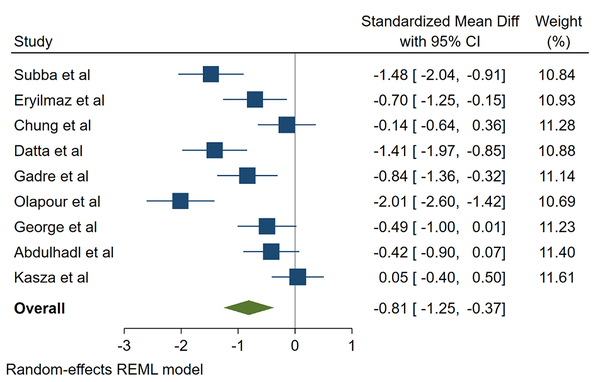
Forest plot of onset motor block
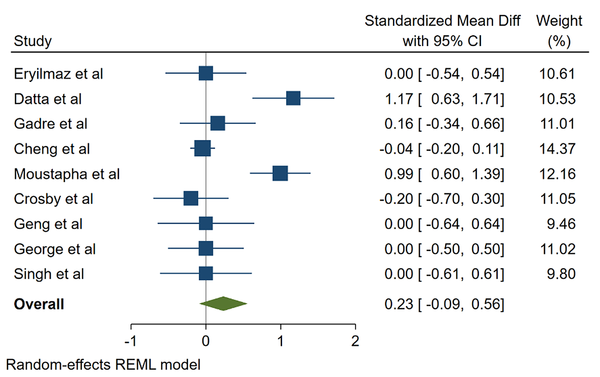
The incidence of shivering was 2.24 times higher in the bupivacaine group than in the ropivacaine group. The average onset time of sensory block (SMD, -0.550) and motor block (SMD, -0.812) was significantly lower in the bupivacaine group than in the ropivacaine group.
A meta-regression test was performed for all parameters, showing the non-significance of the year in the studies. On the other hand, the Egger test indicated no publication bias in the studies (Figure 6).
Funnel plot of hypotension
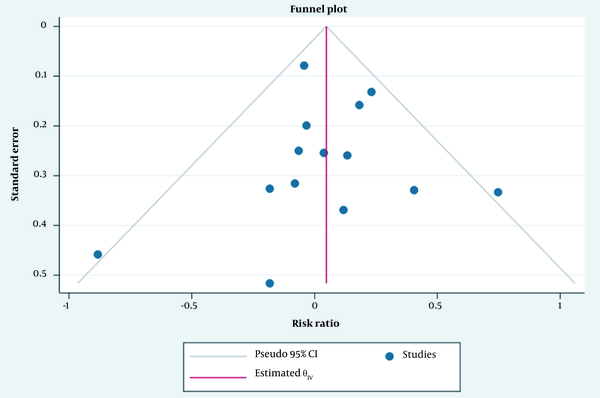
4. Discussion
In cesarean section, anesthesia can affect the mother and fetus (29). Anesthesia should not only provide adequate analgesia for the mother after cesarean section but also should have minimal effects on the relationship between the baby and the mother (30). The rapid onset of anesthesia, high success rate, fewer side effects, reduction of aspiration, and reduced mortality rate are among the advantages of spinal anesthesia in cesarean section (31-33). Our study showed that intrathecal bupivacaine vs. ropivacaine in cesarean section had no statistically significant difference in the incidence of hypotension, bradycardia, and Apgar score of newborns. Although the incidence of nausea, vomiting, and shivering was significantly higher in the bupivacaine group than in the ropivacaine group, the onset of sensory and motor block was faster in the bupivacaine group than in the ropivacaine group.
Bhattari et al. found that intrathecal bupivacaine vs. ropivacaine in cesarean section under spinal anesthesia had no statistically significant difference in the incidence of hypotension and bradycardia between the 2 groups (15). The incidence of nausea, vomiting, and shivering was significantly higher in the bupivacaine group than in the ropivacaine group. The onset of sensory block was faster in the bupivacaine group than in the ropivacaine group; however, the ropivacaine group had a shorter recovery (15). In another study, Ghazi et al. showed that blood pressure and the time to reach the appropriate level of anesthesia were significantly lower in the bupivacaine group than in the ropivacaine group (7). The time to decrease the level of anesthesia, the rate of nausea and vomiting, hypotension, and the use of ephedrine were significantly lower in the ropivacaine group than in the bupivacaine group (7).
In a similar study, Olapour et al. concluded that the duration of sensory and motor block was shorter in the ropivacaine group than in the bupivacaine group (17). There was no statistically significant difference in blood pressure between the 2 groups, but the heart rate was significantly higher in the bupivacaine group than in the ropivacaine group (17). Günaydin and Eryilmaz found that the onset of sensory and motor block was faster in the bupivacaine group than in the ropivacaine, and the duration of motor block was longer in the bupivacaine group than in the ropivacaine (28). No difference was observed in the hemodynamic changes of the 2 groups (28).
Canan et al. observed no statistically significant difference in hemodynamic changes, duration of anesthesia, Apgar score, pain, and onset of sensory and motor block between the 2 groups (8). The finding of Chung et al. and Singh et al. are consistent with the present study (16, 18). In the current study, the incidence of shivering, nausea, and vomiting was higher in the bupivacaine group than in the ropivacaine group, which is consistent with some previous studies (15, 16, 34, 35).
Cesarean section patients, especially those under spinal anesthesia, often complain of pain, nausea, vomiting, and shivering (36). Nausea is caused by the stimulation of chemoreceptors by opiates and hypotension (37). The shivering in cesarean section patients is caused by the acceleration of blood circulation, high metabolism in the late third trimester of pregnancy, and loss of heat during childbirth. The compensatory vasoconstriction in non-blocked areas caused by low blood pressure after anesthesia can increase the prevalence of shivering (1). Previous studies have indicated that in the management of shivering in cesarean section, ropivacaine is more suitable than bupivacaine (38), which is consistent with the present study. Both drugs had similar effects on the Apgar score of infants, which is consistent with some previous studies (9-11, 16, 39, 40). The onset time of sensory and motor block was less in the bupivacaine group than in the ropivacaine group.
Bupivacaine is a long-acting amide local anesthetic that causes cardiotoxicity. Since this side effect can cause problems for some pregnant women, ropivacaine has been developed to avoid it (11). Ropivacaine is a local anesthetic with a structure similar to bupivacaine. Ropivacaine has advantages such as separated sensory and motor block with fewer complications in the cardiovascular and central nervous systems, hemodynamic stability, less fat solubility, and faster recovery (41).
Since ropivacaine has a greater sensory block than bupivacaine, it leads to earlier motor activity and faster recovery (11). Although bupivacaine is more potent than ropivacaine for spinal anesthesia, it can be a good choice in shorter surgeries when rapid recovery is required. Fast recovery can bring more patient satisfaction (15). Gadre et al. found that ropivacaine had better clinical effects than bupivacaine in cesarean section patients, including shorter duration of motor and sensory block, high level of block, hemodynamic stability, and adequate analgesia after surgery (11).
Due to its low effects on the uterus, placenta, and hemodynamics of mothers, ropivacaine is suitable for anesthesia during cesarean section (6). Kathuria et al. reported that the use of ropivacaine in spinal anesthesia reduced complications in mothers and had better effects than traditional anesthetics (42). Several studies have suggested that in cesarean section, ropivacaine reduces motor block more significantly than bupivacaine (43). Fast recovery, early movement with fewer side effects, and safety of the fetus have made this drug desirable in cesarean section (11).
4.1. Conclusions
Although both ropivacaine and bupivacaine are effective in cesarean section, ropivacaine is more recommended due to fewer hemodynamic changes, shorter duration of sensory and motor block, fewer side effects, and faster recovery. These points can be important in patients with hemodynamic instability, such as pregnant women with heart diseases.
4.2. Limitations and Strengths
The small number of articles is one of the limitations of this study. Lack of bias in entering studies, the absence of language restrictions, and analysis of all parameters were the strengths of this study.
Acknowledgements
References
-
1.
Liu X, Zhang X, Wang X, Wang J, Wang H. Comparative evaluation of intrathecal bupivacaine alone and bupivacaine combined with dexmedetomidine in cesarean section using spinal anesthesia: a meta-analysis. J Int Med Res. 2019;47(7):2785-99. [PubMed ID: 31204535]. [PubMed Central ID: PMC6683877]. https://doi.org/10.1177/0300060518797000.
-
2.
Hellerstein S, Feldman S, Duan T. China's 50% caesarean delivery rate: is it too high? BJOG. 2015;122(2):160-4. [PubMed ID: 25138909]. https://doi.org/10.1111/1471-0528.12971.
-
3.
Pasha N, Anand S, Rao DG. Comparative study of isobaric levobupivacaine and hyperbaric bupivacaine for subarachnoid block in elective cesarean sections. Anaesth Pain Intensive Care. 2020;24(2):215-22. https://doi.org/10.35975/apic.v24i2.1258.
-
4.
Jaafarpour M, Taghizadeh Z, Shafiei E, Vasigh A, Sayehmiri K. The Effect of Intrathecal Meperidine on Maternal and Newborn Outcomes After Cesarean Section: A Systematic Review and Meta-Analysis Study. Anesth Pain Med. 2020;10(2). e100375. [PubMed ID: 32637349]. [PubMed Central ID: PMC7322789]. https://doi.org/10.5812/aapm.100375.
-
5.
Bahadori F, Hakimi S, Heidarzade M. The trend of caesarean delivery in the Islamic Republic of Iran. East Mediterr Health J. 2014;19 Suppl 3:S67-70. [PubMed ID: 24995763].
-
6.
Cheng Q, Zhang W, Lu Y, Chen J, Tian H. Ropivacaine vs. levobupivacaine: Analgesic effect of combined spinal-epidural anesthesia during childbirth and effects on neonatal Apgar scores, as well as maternal vital signs. Exp Ther Med. 2019;18(3):2307-13. [PubMed ID: 31410181]. [PubMed Central ID: PMC6676164]. https://doi.org/10.3892/etm.2019.7776.
-
7.
Ghazi A, Yosefian M, Zandyan H, Habibzadeh E. [Comparison of the Effect of Intrathecal Bupivacaine with Intrathecal Ropivacaine on Hemodynamic of Patients under Elective Caesarean Section]. J Anesth Pain. 2022;12(4):60-71. Persian.
-
8.
Canan U, Ornek D, Kilci O, Donmez F, Gamli M, Dikmen B. Comparison of the maternal and neonatal effects of bupivacaine plus fentanyl and ropivacaine plus fentanyl during cesarean delivery. Niger J Clin Pract. 2013;16(2):195-200. [PubMed ID: 23563461]. https://doi.org/10.4103/1119-3077.110154.
-
9.
Yumnam AS, Debbarma B, Laithangbam PKS, Singh TH, Singh TR, Singh NR. A comparative study of hyperbaric bupivacaine (0.5%) with hyperbaric levobupivacaine for spinal anesthesia in cesarean section: A randomized, controlled trial. J Med Soc. 2017;31(1). https://doi.org/10.4103/0972-4958.198439.
-
10.
Gomaa HM, Mohamed NN, Zoheir HAH, Ali MS. A comparison between post-operative analgesia after intrathecal nalbuphine with bupivacaine and intrathecal fentanyl with bupivacaine after cesarean section. Egypt J Anaesth. 2019;30(4):405-10. https://doi.org/10.1016/j.egja.2014.03.008.
-
11.
Gadre AK, Bandyopadhyay KH, Dutta C, Nag T. A Comparative Study of Intrathecal Isobaric 0.5% Bupivacaine and Intrathecal Isobaric 0.75% Ropivacaine in Elective Lower Segment Cesarean Section. J Pharmacol Pharmacother. 2022;10(4):126-31. https://doi.org/10.4103/jpp.JPP_80_19.
-
12.
Rudra A, Halder R, Sen A, Kundu S. Efficacy of low dose propofol for control of emetic episodes during caesarean delivery with spinal anaesthesia. Indian J Anaesth. 2004;48(1):31-4.
-
13.
Bano F, Sabbar S, Zafar S, Rafeeq N, Iqbal MN, Haider S, et al. Intrathecal fentanyl as adjunct to hyperbaric bupivacaine in spinal anesthesia for caesarean section. J Coll Physicians Surg Pak. 2006;16(2):87-90. [PubMed ID: 16499796].
-
14.
Bhat SN, Upadya M; Himaldev. Comparison of efficacy and safety of ropivacaine with bupivacaine for intrathecal anesthesia for lower abdominal and lower limb surgeries. Anesth Essays Res. 2013;7(3):381-5. [PubMed ID: 25885988]. [PubMed Central ID: PMC4173549]. https://doi.org/10.4103/0259-1162.123252.
-
15.
Bhattarai R, Arjun Chhetri A, Subba S. Comparison of effects of Bupivacaine and Ropivacaine in patients undergoing elective Caesarean section. Birat J Health Sci. 2020;4(3):859-63. https://doi.org/10.3126/bjhs.v4i3.27042.
-
16.
Chung CJ, Choi SR, Yeo KH, Park HS, Lee SI, Chin YJ. Hyperbaric spinal ropivacaine for cesarean delivery: a comparison to hyperbaric bupivacaine. Anesth Analg. 2001;93(1):157-61. [PubMed ID: 11429357]. https://doi.org/10.1097/00000539-200107000-00031.
-
17.
Olapour A, Akhondzadeh R, Rashidi M, Gousheh M, Homayoon R. Comparing the Effect of Bupivacaine and Ropivacaine in Cesarean Delivery with Spinal Anesthesia. Anesth Pain Med. 2020;10(1). e94155. [PubMed ID: 32337166]. [PubMed Central ID: PMC7144247]. https://doi.org/10.5812/aapm.94155.
-
18.
Singh S, Singh VP, Jain M, Gupta K, Rastogi B, Abrol S. Intrathecal 0.75% isobaric ropivacaine versus 0.5% heavy bupivacaine for elective cesarean delivery: A randomized controlled trial. J Pioneering Med Sci. 2012;2:75-8.
-
19.
Datta S, Camann W, Bader A, VanderBurgh L. Clinical effects and maternal and fetal plasma concentrations of epidural ropivacaine versus bupivacaine for cesarean section. Anesthesiology. 1995;82(6):1346-52. [PubMed ID: 7793647]. https://doi.org/10.1097/00000542-199506000-00004.
-
20.
Diouf E, Beye MD, Fall ML, Sarr N, Dia CA, Thiam O, et al. Bupivacaine-Fentanyl vs Ropivacaine-Fentanyl: Evaluation of two Spinal Anesthesia Protocols for Emergency Cesarean Section. J Drug Deliv Ther. 2020;10(6-s):3-7. https://doi.org/10.22270/jddt.v10i6-s.4403.
-
21.
Geng ZY, Wang DX, Wu XM. Minimum effective local anesthetic dose of intrathecal hyperbaric ropivacaine and bupivacaine for cesarean section. Chin Med J (Engl). 2011;124(4):509-13. [PubMed ID: 21362272].
-
22.
Feng G, Wang Y, Feng J, Luo X, Li C, Yao S. The relationship between core temperature and perioperative shivering during caesarean section under intrathecal anesthesia with bupivacaine and ropivacaine: a randomized controlled study. J Anesth. 2021;35(6):889-95. [PubMed ID: 34476612]. [PubMed Central ID: PMC8595161]. https://doi.org/10.1007/s00540-021-02995-9.
-
23.
Crosby E, Sandler A, Finucane B, Writer D, Reid D, McKenna J, et al. Comparison of epidural anaesthesia with ropivacaine 0.5% and bupivacaine 0.5% for caesarean section. Can J Anaesth. 1998;45(11):1066-71. [PubMed ID: 10021954]. https://doi.org/10.1007/BF03012393.
-
24.
Geng G, Li W, Huang S. Pulmonary effects of bupivacaine and ropivacaine in parturients undergoing spinal anesthesia for elective cesarean delivery. Int J Clin Exp Med. 2014;7(5):1417-21. [PubMed ID: 24995105]. [PubMed Central ID: PMC4073766].
-
25.
George M, Ipe S, Ipe S, Abraham SP. Spinal anesthesia for elective cesarean section – Comparison of levobupivacaine and ropivacaine with hyperbaric racemic bupivacaine. Asian J Pharm Res Health Care. 2022;14(2). https://doi.org/10.4103/ajprhc.ajprhc_25_22.
-
26.
Al-Abdulhadi O, Biehl D, Ong B, Boker A. Hyperbaric spinal for elective Cesarean section--ropivacaine vs bupivacaine. Middle East J Anaesthesiol. 2007;19(2):385-96. [PubMed ID: 17684878].
-
27.
Kasza T, Knapik P, Misiołek H, Knapik D. Comparison of spinal anaesthesia with 0.75% ropivacaine and 0.5% bupivacaine for elective caesarean section. Ann Acad Med Siles. 2009;63(6):15-22.
-
28.
Günaydin B, Eryilmaz NC. A comparison of the effects of intrathecal ropivacaine and bupivacaine during cesarean section*. Turk J Med Sci. 2011;41(2):219-26. https://doi.org/10.3906/sag-1008-994.
-
29.
Gizzo S, Noventa M, Fagherazzi S, Lamparelli L, Ancona E, Di Gangi S, et al. Update on best available options in obstetrics anaesthesia: perinatal outcomes, side effects and maternal satisfaction. Fifteen years systematic literature review. Arch Gynecol Obstet. 2014;290(1):21-34. [PubMed ID: 24659334]. https://doi.org/10.1007/s00404-014-3212-x.
-
30.
Mueller NT, Whyatt R, Hoepner L, Oberfield S, Dominguez-Bello MG, Widen EM, et al. Prenatal exposure to antibiotics, cesarean section and risk of childhood obesity. Int J Obes (Lond). 2015;39(4):665-70. [PubMed ID: 25298276]. [PubMed Central ID: PMC4390478]. https://doi.org/10.1038/ijo.2014.180.
-
31.
Rastegarian A, Ghobadifar MA, Kargar H, Mosallanezhad Z. Intrathecal Meperidine Plus Lidocaine for Prevention of Shivering during Cesarean Section. Korean J Pain. 2013;26(4):379-86. [PubMed ID: 24156005]. [PubMed Central ID: PMC3800711]. https://doi.org/10.3344/kjp.2013.26.4.379.
-
32.
Shami S, Nasseri K, Shirmohammadi M, Sarshivi F, Ghadami N, Ghaderi E, et al. Effect of low dose of intrathecal pethidine on the incidence and intensity of shivering during cesarean section under spinal anesthesia: a randomized, placebo-controlled, double-blind clinical trial. Drug Des Devel Ther. 2016;10:3005-12. [PubMed ID: 27703328]. [PubMed Central ID: PMC5036596]. https://doi.org/10.2147/DDDT.S115201.
-
33.
Pang G, Zhu Y, Zhou Y, Tong S. The Anesthetic Effect and Safety of Dexmedetomidine in Cesarean Section: A Meta-Analysis. Biomed Res Int. 2022;2022:1681803. [PubMed ID: 35607304]. [PubMed Central ID: PMC9124121]. https://doi.org/10.1155/2022/1681803.
-
34.
Hu J, Zhang C, Yan J, Wang R, Wang Y, Xu M. Sufentanil and Bupivacaine Combination versus Bupivacaine Alone for Spinal Anesthesia during Cesarean Delivery: A Meta-Analysis of Randomized Trials. PLoS One. 2016;11(3). e0152605. [PubMed ID: 27032092]. [PubMed Central ID: PMC4816294]. https://doi.org/10.1371/journal.pone.0152605.
-
35.
Arzola C, Wieczorek PM. Efficacy of low-dose bupivacaine in spinal anaesthesia for Caesarean delivery: systematic review and meta-analysis. Br J Anaesth. 2011;107(3):308-18. [PubMed ID: 21764820]. https://doi.org/10.1093/bja/aer200.
-
36.
Bi YH, Wu JM, Zhang YZ, Zhang RQ. Effect of Different Doses of Intrathecal Dexmedetomidine as an Adjuvant Combined With Hyperbaric Ropivacaine in Patients Undergoing Cesarean Section. Front Pharmacol. 2020;11:342. [PubMed ID: 32265713]. [PubMed Central ID: PMC7098998]. https://doi.org/10.3389/fphar.2020.00342.
-
37.
Balki M, Carvalho JC. Intraoperative nausea and vomiting during cesarean section under regional anesthesia. Int J Obstet Anesth. 2005;14(3):230-41. [PubMed ID: 15935649]. https://doi.org/10.1016/j.ijoa.2004.12.004.
-
38.
Wang H, Gao Q, Xu R, Dong W, Zhang Y, Fan J. The efficacy of ropivacaine and bupivacaine in the caesarean section and the effect on the vital signs and the hemodynamics of the lying-in women. Saudi J Biol Sci. 2019;26(8):1991-4. [PubMed ID: 31889783]. [PubMed Central ID: PMC6923449]. https://doi.org/10.1016/j.sjbs.2019.07.014.
-
39.
Deepa T, Chandran D. Effect of addition of intrathecal magnesium sulphate to 0.5% hyperbaric bupivacaine and 0.5% isobaric levobupivacaine on duration of analgesia in parturients undergoing elective caesarean section: A prospective randomised study. J Anaesthesiol Clin Pharmacol. 2021;37(4):633-8. [PubMed ID: 35340961]. [PubMed Central ID: PMC8944347]. https://doi.org/10.4103/joacp.JOACP_87_20.
-
40.
Lirk P, Kleber N, Mitterschiffthaler G, Keller C, Benzer A, Putz G. Pulmonary effects of bupivacaine, ropivacaine, and levobupivacaine in parturients undergoing spinal anaesthesia for elective caesarean delivery: a randomised controlled study. Int J Obstet Anesth. 2010;19(3):287-92. [PubMed ID: 20605441]. https://doi.org/10.1016/j.ijoa.2009.03.015.
-
41.
Gupta R, Bogra J, Singh PK, Saxena S, Chandra G, Kushwaha JK. Comparative study of intrathecal hyperbaric versus isobaric ropivacaine: A randomized control trial. Saudi J Anaesth. 2013;7(3):249-53. [PubMed ID: 24015125]. [PubMed Central ID: PMC3757795]. https://doi.org/10.4103/1658-354X.115326.
-
42.
Kathuria S, Gupta S, Dhawan I. Dexmedetomidine as an adjuvant to ropivacaine in supraclavicular brachial plexus block. Saudi J Anaesth. 2015;9(2):148-54. [PubMed ID: 25829902]. [PubMed Central ID: PMC4374219]. https://doi.org/10.4103/1658-354X.152841.
-
43.
Malhotra R, Johnstone C, Halpern S, Hunter J, Banerjee A. Duration of motor block with intrathecal ropivacaine versus bupivacaine for caesarean section: a meta-analysis. Int J Obstet Anesth. 2016;27:9-16. [PubMed ID: 27106206]. https://doi.org/10.1016/j.ijoa.2016.03.004.